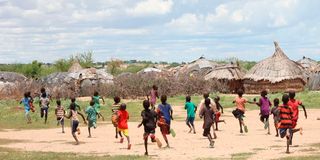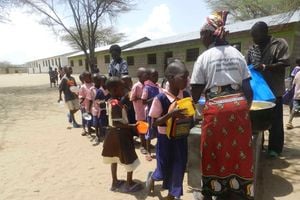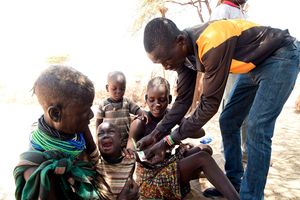New report raises concern over worsening malnutrition among children

Children playing in Illeret, Marsabit County on April 20, 2024. A new report from the National Drought Management Authority (NDMA) has raised concerns over worsening malnutrition among children under five years old in most counties.
What you need to know:
- Efforts to combat malnutrition in Samburu and Turkana counties have suffered a major setback following the suspension of the Sh5 billion USAID Nawiri programme.
A new report from the National Drought Management Authority (NDMA) has raised concerns over worsening malnutrition among children under five years old in a majority of counties.
Malnutrition, in all its forms, includes undernutrition (wasting, stunting, underweight), inadequate vitamins or minerals, overweight, obesity, and resulting diet-related noncommunicable diseases, notes the World Health Organization.
Findings based on Mid-Upper Arm Circumference measurements show a deteriorating trend, with only Marsabit, Nyeri and Taita Taveta counties maintaining stability.
According to NDMA, the decline in child nutrition is driven by limited access to diverse diets, reduced milk consumption and restricted health outreach services.
These factors have heightened malnutrition risks particularly in vulnerable regions.
While approximately 78 per cent of counties reported malnutrition levels within normal ranges, Garissa, Mandera, Turkana, Lamu and West Pokot recorded alarming deviations, signaling an urgent need for intervention.
“The proportion of children at risk of malnutrition remained within the usual range in most counties, but in Garissa, Mandera, Turkana, Lamu and West Pokot the figures exceeded normal levels,” the report stated.
NDMA also attributed the crisis to poor health-seeking behaviour, high morbidity rates and inadequate childcare practices.
In the meantime, efforts to combat malnutrition in Samburu and Turkana counties have suffered a major setback following the suspension of the Sh5 billion USAID Nawiri programme.
The initiative, launched in 2019, aimed to address food insecurity and malnutrition through long-term solutions such as improved food production, clean water access and strengthened healthcare systems.
Before its suspension, the programme had significantly reduced acute malnutrition in the two semi-arid counties.
As of June 2023, the Monitoring and Assessment of Relief and Transitions survey showed that malnutrition prevalence stood at 20.3 per cent in Samburu. In 2021, it stood at 21.8 per cent, meaning at least three in 10 children were affected.
This exceeded the World Health Organization emergency threshold of 15 per cent.
According to the Kenya Demographic Health Survey (KDHS) 2022, Samburu County recorded one of Kenya’s highest stunting rates, exceeding 30 per cent.
This means that a significant number of children under five were too short for their age due to long-term nutritional deficiencies.
Local health officials noted a slight decline in malnutrition cases among children, pregnant women, and breastfeeding mothers, thanks to the USAID Nawiri’s interventions.
Titus Leokoe, Health and Nutrition advisor, said: "We have seen remarkable progress due to interventions that have been put in place over the years.”
Samburu, which was in the past severely affected by three consecutive years of drought, has experienced improved rainfall over the past year. Sufficient rains offered relief to pastoralists who entirely depend on cattle keeping for survival.





